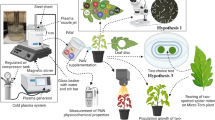Abstract
The life-table study on effects of a heavy metal, Cd (100 and 200 mg kg−1 soil), and an insecticide, imidacloprid (4 and 40 g a.i. ha−1), on pea aphids revealed significant effects of both chemicals on life history traits and population dynamics. Substantial differences in the action of the two chemicals and between the two doses of imidacloprid were observed. The pesticide caused high mortality at the beginning of the experiment, however some aphids were able to live for as long as control insects. In contrast, Cd-induced mortality was low at the beginning but increased during the experiment. Analysis of data collected during the first 10 days of the experiment, the first 20 days, or for the whole life-time of the cohort gave different results. While highly significant effects of imidacloprid were detected already after 10 days of the experiment, Cd treatment resulted in no effect for this time of exposure. Higher dose of imidacloprid decreased growth and development rates along with delayed reproduction (9th or 10th day). In contrast, the aphids treated with the low dose of imidacloprid and with both concentrations of Cd started their reproduction at the same day as untreated insects (6th or 7th day), but the reproduction tended to cease earlier. This indicates that too short ecotoxicological tests may result in serious underestimation of some effects, while overestimating others.
Similar content being viewed by others
References
Crawford, L.A., Lepp, N.W. and Hodkinson, I.D. (1996). Accumulation and egestion of dietary copper and cadmium by the grasshopper Locusta migratoria R&F Othoptera: Acrididae. Environ. Pollut. 92, 241–6.
Depledge, M.H. (1990). New approaches in ecotoxicology: Can inter-individual physiological variability be used as a tool to investigate pollution effects? Ambio 19, 251–2.
Forbes, V.E., Moller, V. and Depledge, M.H. (1995). Intrapopulation variability in sublethal response to heavy metal stress in sexual and asexual gastropod populations. Funct. Ecol. 9, 477–84.
Harrahy, E.A. and Clements, W.H. (1997). Toxicity and bioaccumulation of a mixture of heavy metals in Chironomus tentans Diptera: Chironomidae in synthetic sediment. Environ. Toxicol. Chem. 16, 317–27.
Janssen, M. (1991). Turnover of cadmium through soil arthropods, PhD Thesis. Amsterdam: Vrije Universiteit.
Kraak, M.H.S., Lavy, D., Peeters, W.H.M. and Davids, C. (1992). Chronic ecotoxicity of copper and cadmium to the zebra mussel Dreissena-polymorpha. Arch. Environ. Contam. Toxicol. 23, 363–9.
Kramarz, P. (1999a). The dynamics of accumulation and decontamination of cadmium and zinc in carnivorous invertebrates. 1. The ground beetle, Poecilus cupreus L. Bull. Environ. Contam. Toxicol. 63, 531–7.
Kramarz, P. (1999b). The dynamics of accumulation and decontamination of cadmium and zinc in carnivorous invertebrates. 2. The centipede Lithobius mutabilis Koch. Bull. Environ. Contam. Toxicol. 63, 538–45.
Kramarz, P. and Laskowski, R. (1997). Effect of zinc contamination on life history parameters of a ground beetle Poecilus cupreus. Bull. Environ. Contam. Toxicol. 59, 525–30.
Léon, C.D. and Van Gestel, C.A.M. (1994). Selection of a set of laboratory ecotoxicity tests for the effects assessment of chemicals in terrestrial ecosystems. Amsterdam: Department of Ecology and Ecotoxicology, Vrije Universiteit. Report no. D94004.
Lø kke, H. and van Gestel, C.A.M. (eds) (1998). Handbook of Soil Invertebrate Toxicity Tests. Chichester: John Wiley and Sons.
McGraw, J.B. and Caswell, H. (1996). Estimation of individual fitness from life-history data. Am. Nat. 147, 47–64.
Author information
Authors and Affiliations
Rights and permissions
About this article
Cite this article
Laskowski, R. Why Short-Term Bioassays Are Not Meaningful—Effects of a Pesticide (Imidacloprid) and a Metal (Cadmium) on Pea Aphids (Acyrthosiphon pisum Harris). Ecotoxicology 10, 177–183 (2001). https://doi.org/10.1023/A:1016698012209
Issue Date:
DOI: https://doi.org/10.1023/A:1016698012209




